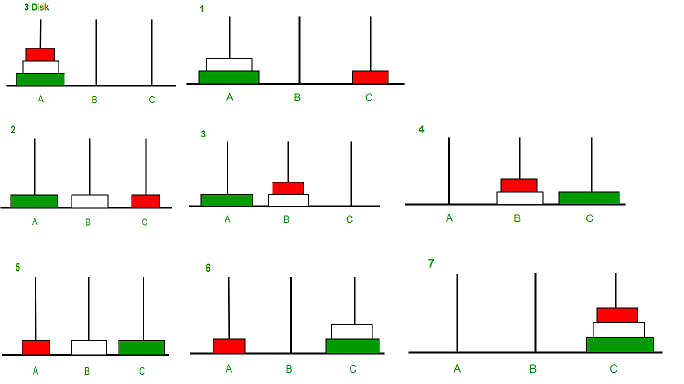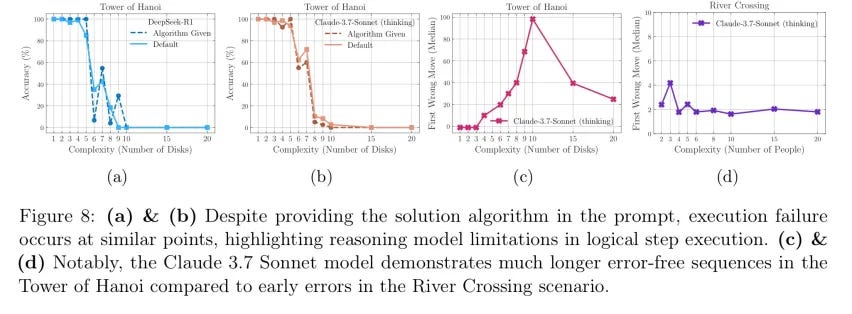A Few Quick Thoughts on Apple's "Illusion of Thinking" LLM Paper
Illusions of illusions of thinking, or, "why Apple's "Illusions of Thinking" Paper Isn't Fair to LLMs"
Note: this is a very rough analysis and I don’t fully do justice to either the Illusion of Thinking paper or Gary’s response. I may eventually come back to this topic and fill out a more complete response.
People keep sharing this new Apple paper about LLMs called “The Illusion of Thinking: Understanding the Strengths and Limitations of Reasoning Models via the Lens of Problem Complexity.” The basic summary of the paper is that LLMs fail at many types of puzzles, sometimes in unintuitive ways, and that as a result the benefits of ‘reasoning’ models may be overstated if not inaccurate. For example, LLMs struggle with Towers of Hanoi, a reasonably simple puzzle where the goal is to move a stack of disks in ascending order from one pile to another, one at a time.

Towers of Hanoi has a well known algorithm that you can use to solve it, and the Apple paper discusses how LLMs seem unable to recover that algorithm.
Folks like Gary Marcus take these results as obvious examples of LLMs being insufficient for AGI.
What the Apple paper shows, most fundamentally, regardless of how you define AGI, is that LLMs are no substitute for good well-specified conventional algorithms.
…
But anybody who thinks LLMs are a direct route to the sort AGI that could fundamentally transform society for the good is kidding themselves. This does not mean that the field of neural networks is dead, or that deep learning is dead. LLMs are just one form of deep learning, and maybe others — especially those that play nicer with symbols – will eventually thrive. Time will tell. But this particular approach has limits that are clearer by the day.
And several people have expanded on takes like Gary’s and gone on to say that “AI” is “just” pattern recognition, and as a result is completely different from what humans do.
A few people have asked me for my take, so here it is.
First, I think this whole debate is just semantics. I don't know a priori why we would define intelligence as being meaningfully different from pattern matching, or why Gary defines AGI to mean something other than what LLMs currently do.
It's worth asking what the point of a definition is. I could tautologically define intelligence as "a property unique to humans" and then we can wipe our hands of the whole debate and say that of course neural networks aren't intelligent since they aren't human. But this obviously feels lacking. It’s like saying “only humans can have souls.” Why?
Semantics debates are often just exercises in question begging, but there is such a thing as a ‘good’ definition’. Definitions serve a purpose! Words are meant to ‘carve reality at the joints,’ that is, to provide clear delineations that help accurately communicate the state of observed reality. And the reality is these models are increasingly indistinguishable from what people are capable of doing. “Intelligence” is often used as a general purpose word to describe "being good at things" so, of course, colloquially many people now say models are intelligent. Because they are good at things. And, in fact, they keep getting better at things! We keep putting barriers in front of them that we think they cannot do, and within a few months they leap over those barriers. I fully expect that someone will have a working Towers of Hanoi LLM by next year.
Personally, I’ve been open in my belief that current models are already AGI for any reasonable definitions of ‘artificial’ and ‘general’ and ‘intelligence’.
Second, I'm not particularly surprised that LLMs are bad at solving puzzles that require learning and consistently applying algorithms. You don't have to reach for puzzles like Towers of Hanoi, most models can't do simple addition of large numbers. The reason is straightforward: it is hard to “learn” the algorithm for addition (add the two numbers on the far right, carry the one if necessary, repeat) just from seeing a lot of examples of addition. But neural networks learn other kinds of circuits, and large neural networks are able to learn some kind of addition algorithm that looks more like modular addition. I think most ML practitioners know to leverage LLMs for fuzzy analysis, and have LLMs write code for symbolic or numeric analysis; the Apple paper is putting some additional rigor around that general intuition.
Does that mean the LLMs aren’t intelligent? Hard to say, but as a counter point I’m not sure I could derive the formula for addition just by looking at symbols. Remember that LLMs aren’t taught like children, they don’t “learn” numbers. The only way they learn about the world is reading text!
Of course, the next obvious thing to test is what happens if you actually give the model the algorithm. Does that result in the model doing better? In theory it should, the model no longer has to ‘recover’ the algorithm from examples.
And in fact the Apple researchers do exactly that, and they find the model does somewhat better but still eventually collapses.
But even this is not a slam dunk against LLMs!
Imagine I asked you to add two numbers with a billion digits each by hand. You presumably know the algorithm for adding things. But do you think, somewhere in those billion additions, you might make a mistake? To solve a puzzle like Towers of Hanoi, you need to a) know the algorithm and b) successfully execute it. But even people are not good at consistently executing algorithms! This is why we built computers! And to that point, LLMs can easily write code to solve Towers of Hanoi. I can ask Claude to do it and it will spit out the result in < 30 seconds.
Credit to Gary, he calls this out, though he quickly dismisses it:
The weakness, which was well-laid out by anonymous account on X (usually not the source of good arguments) was this: (ordinary) humans actually have a bunch of (well-known) limits that parallel what the Apple team discovered. Many (not all) humans screw up on versions of the Tower of Hanoi with 8 discs.
But look, that’s why we invented computers and for that matter calculators: to compute solutions large, tedious problems reliably. AGI shouldn’t be about perfectly replicating a human, it should (as I have often said) be about combining the best of both worlds, human adaptiveness with computational brute force and reliability. We don’t want an “AGI” that fails to “carry the one” in basic arithmetic just because sometimes humans do. And good luck getting to “alignment” or “safety” without reliabilty.
Then let the LLMs write code in your evals! You can have your cake and eat it too if you just let the LLM write code when it has to deal with problems that require computational brute force and reliability.
Here is Claude’s implementation of a 10 disk Towers of Hanoi, complete with a little UX to go with it.

I think a lot of folks who don’t like LLMs are very sloppy in how they evaluate LLMs. Folks like Gary will seamlessly switch between “LLMs should behave in fuzzy ways like humans” and “LLMs should have the rigor and precision of a computer.” This seems unfair — we don’t expect humans to do both of these things.
I think of LLMs as fresh-out-of-college English-major intern. Anything I would expect of an fresh-out-of-college intern with a background in English, I would expect of an LLM. As they say, all models are wrong, some are useful — I’ve found this to be a very accurate heuristic for where LLMs succeed and where they fail. Would I expect my friend who is an incredibly talented creative writer to derive and then execute the algorithm for a 10 disk Tower of Hanoi? No, not any more than I would expect someone to be able to derive the solution to a Rubik’s Cube just by looking at it. Some people can, and good for them, but this is not a reasonable test of anything in particular.
That’s not to say the paper is bad. The Illusions of Thinking paper is actually really interesting, because it is a narrow exploration of where reasoning models fail and where reasoning models can be improved. But I think they dramatically overstate their conclusions when they say that these results point to “fundamental barriers to generalizable reasoning”, and that in turn has fueled a lot of bad pop-science interpretations that differ dramatically from what the paper actually says.
It would be a mistake to assume that because some models display some failure modes today, that no models can solve these problems in the near future. And it is absolutely wrong to assert that these models cannot transform society, especially since they already obviously have done so to anyone paying attention.
The algorithm is the Fibonacci sequence. Each number is mapped 1:1 with a shape and color. The shapes and colors are totally arbitrary, but that is the point — an LLM has no prior understanding of what a ‘token’ is. The arbitrary nature of representing symbols as above is intentionally meant to put you in the frame of what an LLM ‘sees’. How many examples of addition using this mapping would you need before you could figure out an algorithm for addition?






Thanks for the response! A few thoughts in rough order of reading
- it's not obvious to me that reasoning is 'the ability to synthesize rules', nor that this is different from pattern matching, nor that LLMs cannot do this. I think this paper shows LLMs struggle *on these kinds of tasks* but that's different from 'llms can't generalize rules at all ever'
- LLMs also can identify when they make mistakes. They have additional limitations right now due to things like effective context window limitations, but within that window it's been demonstrated that LLMs can identify errors. See the s1 paper.
- it's not obvious to me that an LLM wouldn't be able to solve these problems with enough time and a large enough context window. This is hard to do because it's expensive, but I have no reason to believe it's impossible
I think your response hinges on some causal reason for why LLMs are incapable for learning these things, what you call an "incapability of learning logical rules." The problem is, I disagree that LLMs can't learn logical rules. More generally, no one can point to a causal reason for why such things are *impossible*. Impossible is a big word! The halting problem is impossible. Going faster than the speed of light is impossible. Towers of Hanoi? IDK man, I just don't see it. This paper identifies weaknesses in the current generation of models on a specific subset of tasks, and imo that's really all it shows. It's pretty narrow! I think It's hard to reach for theoretical conclusions about why something doesn't work when we don't even have a particularly good idea of why some of this stuff*does* work
While it's true that the response to this is overblown, I think you're missing an important aspect of reasoning that the LLM's indeed don't show right now, as reasoning in the proper sense is the ability to synthesize rules, which one then tries to follow in a strict sense. LLM's just aren't doing this right now, and therefore they're not really yet doing the whole reasoning business, just approximating it very well. What the paper shows is that the LLM's are unable to construct rules to logically deconstruct a problem, and are also unable to follow a rule-set solving such a problem, even when handed to them. You argue that humans also make mistakes when following such rules, but in some sense this is not true, for when a human is given the algorithm to solve a Rubik's Cube, or a 10 disk Tower of Hanoi, it will eventually solve it by following the algorithm, even when making some mistakes in the meantime, because it can realize that it has made a mistake in following the rules at a certain point, whereafter it can redo the operation to actually succeed in following the rules. Moreover, if the human is careful enough, it should be able to without fail follow the rules to its completion, which makes the whole point about the billion additions kind of redundant. It is perfectly conceivable that a human would be able to solve that, given enough time, yet the crux is that the LLM (as it stands now) is wholly unable to follow such rules strictly enough to ever succeed in such an operation, or solve a complex problem.
Allowing the LLM to use code can allow it to bypass this inherent problem, but as of yet it is still unable to give itself logical rules, and then to abide by these. Robert Brandom has done a lot of philosophical work to show that reasoning is not just pattern-matching, but is the ability to formulate and follow such logical inference-rules, and for example Richard Evans has shown in a PhD at Deepmind how such a system could be implemented in AI. This is also why I agree with you that the paper shouldn't be seen to discount the possibility of reasoning for LLM's, but it does show that the current implementations hit a principled wall, which should prompt us to revise our ideas about what it means to reason for an AI, not just to hope to pattern-match it away, as if you follow Brandom's arguments, mere pattern-matching will never get us to where we want to be.
The real problem is not that LLM's make mistakes, it's really that they aren't even able to make a mistake, as they aren't able to actually follow a logical rule in the first place! You can only make a mistake when you try to do something correctly, but it has no notion of this at all. Yet this seems wholly achievable if we attack the problem it in the right manner.